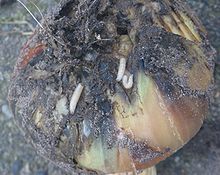- Delia antiqua
-
Delia antiqua 
D. antiqua larvae feeding on Allium porrum Scientific classification Kingdom: Animalia Phylum: Arthropoda Class: Insecta Order: Diptera Family: Anthomyiidae Genus: Delia Species: D. antiqua Binomial name Delia antiqua
(Meigen, 1826)Synonyms Hylemya antiqua Meigen, 1826
Delia antiqua, commonly known as the onion fly, is a cosmopolitan pest of crops. The larvae or maggots feed on onions, garlic and other bulbous plants.
Contents
Morphology and biology
The onion fly has an ash-grey body and resembles a housefly. The male has a longitudinal stripe on the abdomen which is lacking in the female. The legs are black, the wings transparent and the compound eyes brown. The eggs are white and elongated and are laid in groups on the shoots, leaves and bulbs of host plants and on the ground nearby. The larvae are white and cylindrical and hatch in from three to eight days. Each batch tends to keep together and collectively create large cavities in bulbs. More than fifty maggots may feed on one bulb, sometimes originating from eggs laid by several different females. The larvae moult three times, feed for about twenty days and reach a length of about one centimetre. The pupa is brown, ringed and ovoid and measures 7 millimetres (0.28 in) long. Pupation occurs in the ground with the pupal phase from the spring generation lasting two or three weeks. Late generation pupae overwinter in the soil.[1][2]
Distribution
The onion fly is found in North America, Western Europe, Russia, Central Asia, China, Japan and Korea but is absent from deserts. In the far north of its range it is univoltine but further south there may be two, three or four generations in one season.[1]
Economic significance
The larvae damage bulb onions, garlic, chives, shallots, leeks and the bulbs of flowering plants. The first generation of larvae is the most harmful because it extends over a long period owing to the female longevity and occurs when the host plants are small. Seedlings of onion and leek can be severely affected as can thinned out onions and shallots.[2] Less damage occurs in wet and cold springs as this delays the development of the larvae. When plants are attacked, the leaves start to turn yellow and the bulbs rot quickly, especially in damp conditions. Control measures include crop rotation, the use of seed dressings, early sowing or planting, survey and removal of infested plants and autumn digging of the ground to destroy the pupae.[1]
References
- ^ a b c "Delia antiqua (Meigen) - Onion Fly". Interactive Agricultural Ecological Atlas of Russia and Neighboring Countries. http://www.agroatlas.ru/en/content/pests/Delia_antiqua/. Retrieved December 5, 2010.
- ^ a b "Delia antiqua (Meigen)". Encyclopédie des Ravageurs Européens. Institut National de la Recherche Agronomique. http://www.inra.fr/hyppz/RAVAGEUR/6delant.htm. Retrieved December 5, 2010.
Further reading
- Harris, M; Miller, J (1988). "Host-acceptance behaviour in an herbivorous fly, Delia antiqua". Journal of Insect Physiology 34: 179–90. doi:10.1016/0022-1910(88)90048-0.
- Harris, Marion O.; Miller, James R. (July 1983). "Color Stimuli and Oviposition Behavior of the Onion Fly, Delia antiqua (Meigen) (Diptera: Anthomyiidae)". Annals of the Entomological Society of America 76 (4): 766–71. http://openurl.ingenta.com/content?genre=article&issn=0013-8746&volume=76&issue=4&spage=766&epage=771.
Categories:- Anthomyiidae
- Agricultural pest insects
- Animals described in 1826
Wikimedia Foundation. 2010.

